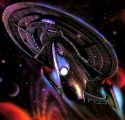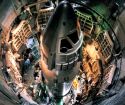|
On April 5, 2063, the future of Terra was changed forever when Zephram Cochrane took his ship, the Phoenix, for its first and only flight. It was the first ship from Terra employing the faster-than-light technology called Warp Propulsion. Because of the nature of such an event, that one flight would lead to humanity's first undenyable contact with an alien species, the formation of the United Federation of Planets, and the expansion of humanity throughout the galaxy. Cochrane, a brilliant though unstable scientist, had worked for years with his aide Lily Sloane to develop and build the Phoenix, using an old nuclear ICBM located in Montana, North America.
Only one day before the flight, however, the entire project was nearly lost when a Borg sphere from the 24th century traveled through time and began firing on the Phoenix's location. Luckily, the U.S.S. Enterprise NCC-1701-E was able to follow the Borg ship and destroy it before critical damage was done. Engineering crews from the Enterprise immediately began repair work on the Phoenix to get it's flight back on schedule, and on the next day, Doctor Cochrane, Commander William Riker, and Lt. Commander Geordi LaForge launched the Phoenix into history. While they did not know it at the time, the Phoenix was almost lost a second time, nearly missed by a photon torpedo fired by the Borg-controlled Enterprise. The ship made it to warp, and was detected by an early Vulcan scoutship, the T'Plana Hath, which trailed it back to Terra. That night, the Vulcans made first contact with Terrans, through Cochrane and the others in the community where he lived; in addition, the Enterprise crew was able to overthrow the Borg invaders and travel back to its proper time. Through these incredible series of events, the Phoenix was able to live up to it's namesake and rise from the ashes of war to create an era of peace and prosperity.
|


































































